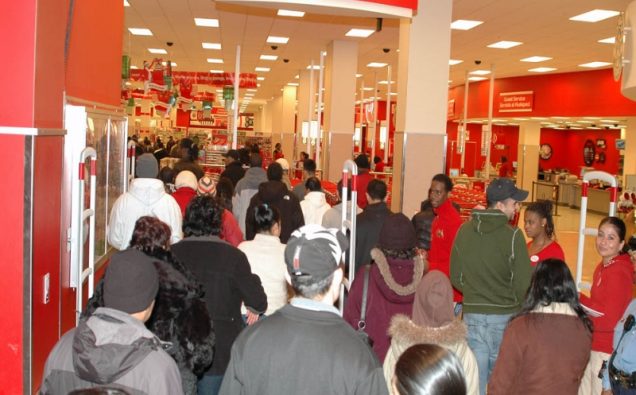
A view of Target Black Friday shopping DCUSA Photo: Gridprop/Wikimedia Commons
Driven by increases in consumer spending, inventory investment, business investment, and exports, the U.S. economy grew at 3.0% pace in the third quarter of 2017, keep up over three percent GDP expansion for the second successive quarter.
“This is the second straight quarter that the economy grew at a 3 percent pace,” the Bureau of Economic Analysis said while releasing the estimates for the third quarter during which major hurricanes including Harvey and Irma caused severe damage and flooding in several U.S. states.
During the second quarter the U.S. economy had grown at a 3.1 percent pace, according to the Department of Commerce.
The last time the economy grew at a 3 percent pace for two consecutive quarters was three years ago, according to BEA.
“Today’s release of the gross domestic product growth for Q3 2017 proves that President Trump’s bold agenda is steadily overcoming the dismal economy inherited from the previous Administration,”Commerce Secretary Wilbur Ross said.
“This is a remarkable achievement in view of the recent hurricanes which have shattered so many lives. As we work together to help those areas recover, I am confident that they will rebound stronger than ever before. And as the President’s tax cut plan is implemented, our entire economy will continue to come roaring back,” Ross added in a statement.
The increase in real GDP reflected increases in consumer spending, inventory investment, business investment, and exports, the BEA said.
A notable offset to these increases was a decrease in housing investment. Imports, which are a subtraction from GDP, decreased.
“The increase in consumer spending reflected increases in spending on both goods and services. The increase in goods was mostly attributable to motor vehicles, and the increase in services primarily reflected increases in health care, in financial services and insurance, and in food services and accommodations.
“The increase in inventory investment primarily reflected increases in wholesale and in manufacturing inventories. The increase in business investment reflected increases in equipment and in intellectual property products; these increases were partly offset by a decrease in structures investment.
Estimates in other areas of the economy as released by the BEA:
Decrease in housing investment primarily reflected a decrease in brokers’ commissions.
Prices of goods and services purchased by U.S. residents increased 1.8 percent in the Percent change Oct27third quarter of 2017 after increasing 0.9 percent in the second quarter of 2017.
Food prices increased in the third quarter following a larger increase in the second quarter of 2017. Energy prices increased in the third quarter of 2017 following a decrease in the second quarter of 2017.
Excluding food and energy, prices increased 1.7 percent in the third quarter of 2017, compared with an increase of 1.3 percent in the second quarter of 2017.

















